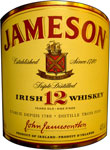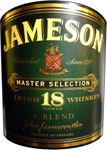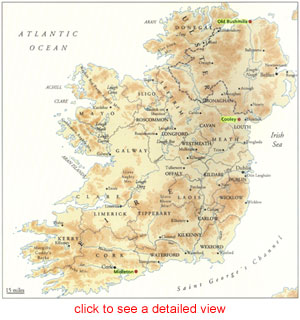| |||||
| |||||
Ireland: 
The cradle of Whiskey

It is alleged that it was Saint Patrick, who led a group of monks to Ireland in 432, brought Christianity to Ireland. In addition to spreading the word of God, they brought with them the art of distillation and uisge beatha - the Irish Gaelic word for water of life. These early spirits were used for medicinal purposes and were often flavoured with honey and herbs.
It wasn't until 1170, when King Henry II of England invaded Ireland, that the joys of this elixir, which eventually became known simply as whiskey, were discovered. The first documented production of Irish whiskey can be traced back to 1276 and the Old Bushmills distillery located in Northern Ireland's County Antrim. It is here where the world's first whiskey distillery license was granted in 1608.
Sadly, it wasn't long before the English government discovered that it could tax alcohol. On Christmas Day 1661 the English imposed a tax of four pence per gallon. It has risen ever since and has been copied almost everywhere! The cunning Irish, however, were not discouraged. By the end of the eighteen-century there were some 2,000 distilleries in Ireland, the vast majority of them being illegal.
As a part of the United Kingdom, in 1823 English Parliament legalized some 160 large distilleries. These were dominated by two large Dublin family companies, John Jameson and John Power. Irish whiskey, along with French Cognac, became the world's leading discerning spirits.
Meanwhile, in 1831 Aeneas Coffey a former inspector at the Dublin customs house, developed the cost-effective method of continuous distillation. The Irish rejected it because it changed the flavour of their traditional pot stilled whiskeys. No such scruples existed in the Scotland. Indeed, it was Scotch whiskey merchant Andrew Usher who in 1853 created the first "blend" of single malts with the smooth grain alcohol from the "Coffey still" in Scotland.
The arrival of cheaper Scottish whisky (without the e) blends seriously dampened demand for Irish single malts. This combined with 1916 Irish war of independence, English embargo and partition of Ireland in 1919 meant that the US was Ireland's last refuge for exports. With the start of Prohibition (1920- 1933), the industry collapsed. Only embargo-exempt Old Bushmills in Northern Ireland was able to thrive.
In 1966, three of the remaining four Irish distilleries merged. Cork, Jameson and Power became Irish Distillers. Old Bushmills joined them in 1972, which meant that every bottle of Irish whiskey was made by a single firm! In 1975 most of the production was moved to a state of the art new distillery in Midleton just east of Cork on the south coast, leaving Old Bushmills as Ireland's only other distillery.
As size matters when it comes to marketing, it wasn't too long before Irish Distillers was scooped up by the French-owned firm of Pernod-Ricard in 1988. It is amazing to think that for one year, a French firm produced every brand and bottle of Irish whiskey. Their traditional Irish whiskey formula meant triple distillation and the use of unpeated, unmalted barley.
That changed on Easter Sunday 1989 when a group of businessmen started a rival firm called Cooley in Dundalk, just south of the border near the Irish Sea. The group resurrected brands from distilleries of the past: Kilbeggan, Locke's, Millar's, The Tryconnell, Connemara and Magilligan, as well as, Clontarf under contract. In contrast to Irish Distilleries, they utilized techniques traditionally used in Scotland, including malted barley, double distillation and even peated malt.
Today, both companies produce a wide variety of styles for every taste. While blends are the order of the day at all three distilleries, they also produce a wide variety of single malts. Midleton, produces a variety of pure pot still whiskeys under various labels, such as Power's, Redbreast, Green Spot, etc. It also has an extensive selection of "Very Rare" vintage dated whiskeys, which have yet to appear in Ontario. It is worth noting that last summer, the UK conglomerate Diageo acquired the Old Bushmills distillery from Pernod-Ricard, putting it back into English hands.
 The world's largest selling Irish whiskey is Jameson Irish Whiskey (10157) at $29.20. It has a honeyed floral nose with a dab of fresh ground pepper. It is smooth, faintly sweetish and gently spicy on the palate with some honey and vanilla wafer notes on the finish. This whiskey is also available in other bottle sizes, namely in 200 ml (605808 - $8.55), 375 ml (230987 - $15.15) and 1140 ml (601013 - $38.60, which includes a special $2 LTO until March 30).
The world's largest selling Irish whiskey is Jameson Irish Whiskey (10157) at $29.20. It has a honeyed floral nose with a dab of fresh ground pepper. It is smooth, faintly sweetish and gently spicy on the palate with some honey and vanilla wafer notes on the finish. This whiskey is also available in other bottle sizes, namely in 200 ml (605808 - $8.55), 375 ml (230987 - $15.15) and 1140 ml (601013 - $38.60, which includes a special $2 LTO until March 30).
 Stepping up a notch is Jameson 12 Years Old Irish Whiskey (144980) at $40.80. The nose is considerably more pungent with a hint of white pepper and a touch of vanilla stick. It is more assertive on the palate with deep, slightly spicy, caramel and honeyed vanilla stick flavours followed up by a lingering, harmonious finish.
Stepping up a notch is Jameson 12 Years Old Irish Whiskey (144980) at $40.80. The nose is considerably more pungent with a hint of white pepper and a touch of vanilla stick. It is more assertive on the palate with deep, slightly spicy, caramel and honeyed vanilla stick flavours followed up by a lingering, harmonious finish.
 At the top comes the slightly darker coloured Jameson 18 Years Old Master Selection (Vintages 600478) at $94.35. While the nose is a more intense with refined caramel-pepper notes, the palate shows great complexity with nuts, dried fruit and elegant honeyed-caramel flavours along with some dried ripe lemon notes on the lingering finish. Buyer alert! This whiskey is on allocation with only 6 Toronto stores having a few bottles.
At the top comes the slightly darker coloured Jameson 18 Years Old Master Selection (Vintages 600478) at $94.35. While the nose is a more intense with refined caramel-pepper notes, the palate shows great complexity with nuts, dried fruit and elegant honeyed-caramel flavours along with some dried ripe lemon notes on the lingering finish. Buyer alert! This whiskey is on allocation with only 6 Toronto stores having a few bottles.
As for other brands, the Irish Whiskey catagory is pretty meager. A search of "Irish Whiskey" on the LCBO website turns up 15 listings, but 7 are virtually gone and the 8th has been discontinued. There are only four items in Vintages, two from the March 1st release and the untasted ISD Greenore 10-Year-Old Single Grain Irish Whiskey ($74.95), which is supposedly to be released on March 15th. In fact, it was released on February 29th and is not found under the "Irish Whiskey" search as it is misspelled without the "e" (as in Scotch Whisky). The other two brands available are Greenore 8 Year Old Single Grain Irish Whiskey ($62.95) and Connemara Cask Strength Peated Single Malt Irish Whiskey ($79.95).


